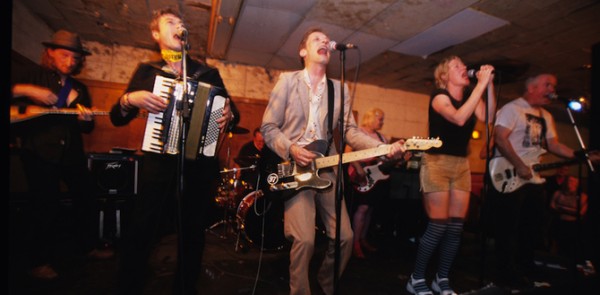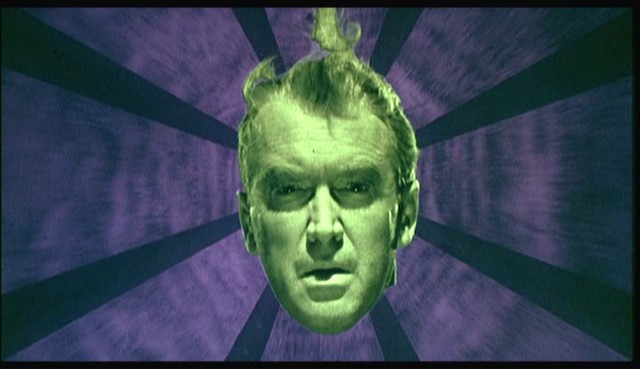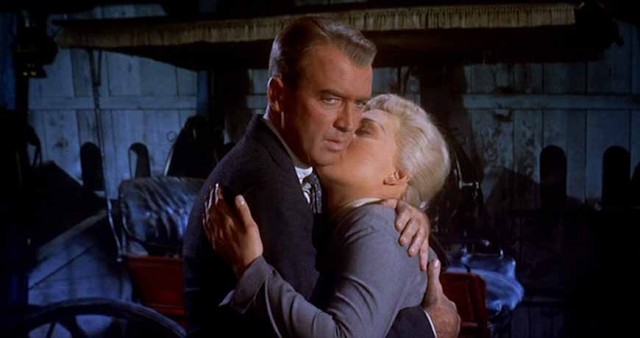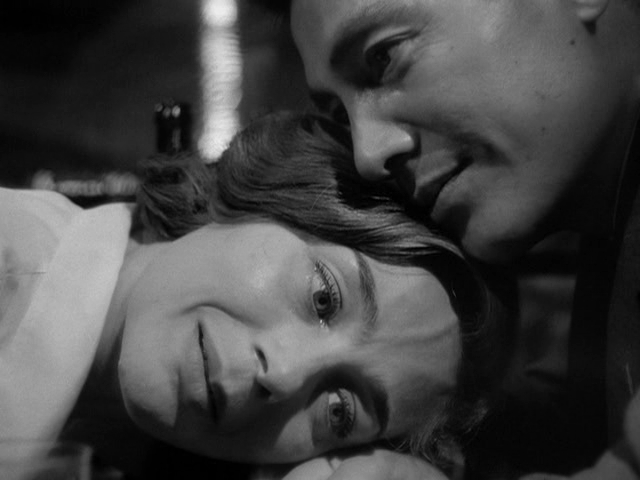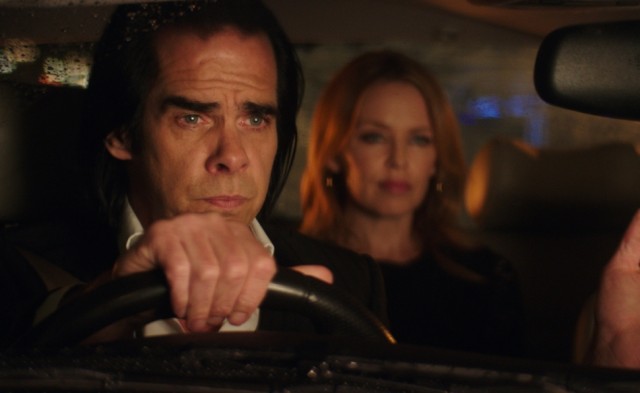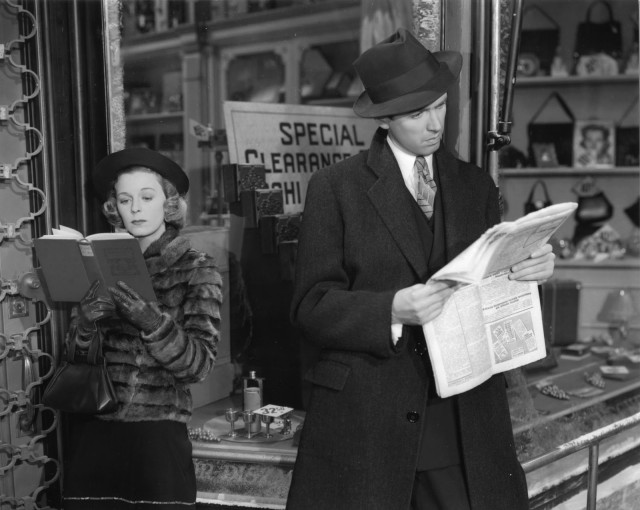
Klara Novak (Margaret Sullavan) and Alfred Kralik (James Stewart) have little time for each other in Ernst Lubitsch’s THE SHOP AROUND THE CORNER
THE SHOP AROUND THE CORNER (Ernst Lubitsch, 1940)
Film Forum
209 West Houston St.
December 25-31
212-727-8110
www.filmforum.org
 Jimmy Stewart’s most famous Christmas movie might be It’s a Wonderful Life, but that doesn’t mean it’s his best. That distinction belongs to the 1940 Ernst Lubitsch black-and-white romantic comedy The Shop Around the Corner, which is having a special holiday run December 25-31 at Film Forum. Stewart stars as Alfred Kralik, a serious-minded longtime clerk at the Budapest gift shop Matuschek & Co., serving as the right-hand man to owner Hugo Matuschek (The Wizard of Oz’s Frank Morgan), who relies on his star employee’s honesty and expertise. Also working at the store is Pirovitch (Felix Bressart), a timid family man who hides every time Mr. Matuschek asks for an opinion; the shy Flora Kaczek (Sara Haden); the brash, ambitious delivery boy Pepi Katona (William Tracy); and the self-involved would-be bon vivant Ferencz Vadas (Joseph Schildkraut). When Klara Novak (Margaret Sullavan) shows up looking for a job, Kralik tries to quickly dismiss her, but she ends up charming Mr. Matuschek and getting hired. She and Kralik, her direct superior, bicker constantly, each one hoping that a romantic pen pal will make their dreary lives much brighter, especially as Christmas approaches. But little do they know the love letters that they are so carefully crafting are actually to each other, their secretive literary relationship a far cry from their actual daily one.
Jimmy Stewart’s most famous Christmas movie might be It’s a Wonderful Life, but that doesn’t mean it’s his best. That distinction belongs to the 1940 Ernst Lubitsch black-and-white romantic comedy The Shop Around the Corner, which is having a special holiday run December 25-31 at Film Forum. Stewart stars as Alfred Kralik, a serious-minded longtime clerk at the Budapest gift shop Matuschek & Co., serving as the right-hand man to owner Hugo Matuschek (The Wizard of Oz’s Frank Morgan), who relies on his star employee’s honesty and expertise. Also working at the store is Pirovitch (Felix Bressart), a timid family man who hides every time Mr. Matuschek asks for an opinion; the shy Flora Kaczek (Sara Haden); the brash, ambitious delivery boy Pepi Katona (William Tracy); and the self-involved would-be bon vivant Ferencz Vadas (Joseph Schildkraut). When Klara Novak (Margaret Sullavan) shows up looking for a job, Kralik tries to quickly dismiss her, but she ends up charming Mr. Matuschek and getting hired. She and Kralik, her direct superior, bicker constantly, each one hoping that a romantic pen pal will make their dreary lives much brighter, especially as Christmas approaches. But little do they know the love letters that they are so carefully crafting are actually to each other, their secretive literary relationship a far cry from their actual daily one.
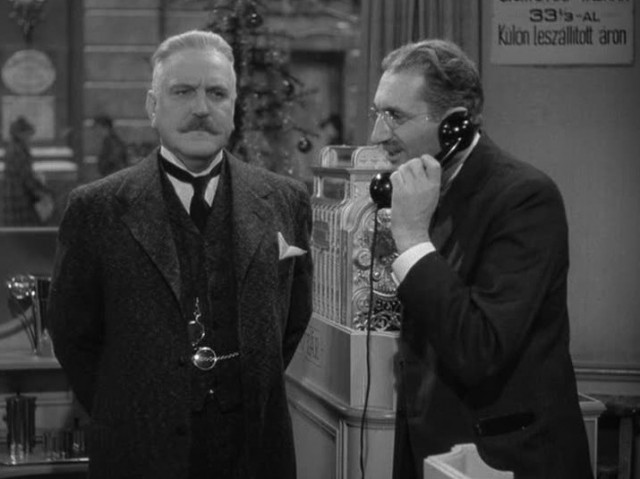
Mr. Matuschek (Frank Morgan) and Pirovitch (Felix Bressart) prepare for Christmas in THE SHOP AROUND THE CORNER
The Shop Around the Corner is based on Miklós László’s 1937 play, Parfumerie, and it very much has a claustrophobic feel, as events occur primarily in the small store. Stewart and Sullavan channel some of that Cary Grant / Irene Dunne magic as they go about their private and professional business, even if they don’t even make attempts at Hungarian accents. (Neither does Morgan, who gives one of his finest performances.) “There might be a lot we don’t know about each other. You know, people seldom go to the trouble of scratching the surface of things to find the inner truth,” Mr. Kralik says to Miss Novak, who replies, “Well, I really wouldn’t care to scratch your surface, Mr. Kralik, because I know exactly what I’d find. Instead of a heart, a handbag. Instead of a soul, a suitcase. And instead of an intellect, a cigarette lighter . . . which doesn’t work.” The central object in the shop is a cigarette box that plays the Eastern European folk song “Ochi Tchornya” every time it is opened; while Mr. Kralik thinks that smokers will tire of hearing the same tune over and over, Miss Novak convinces a customer that it is a candy box and that the repetition of the song will turn her away from opening the box again and again to eat more; meanwhile, Mr. Matuschek just wants to sell the darn things, delineating the three characters’ approach to life in general. Written by Samson Raphaelson, who adapted other plays and novels for Lubitsch, including The Smiling Lieutenant, Trouble in Paradise, and Heaven Can Wait, The Shop Around the Corner is a sweetly innocent film with just the right amount of edginess, a fun frolic through human nature and love, a fanciful confection set in the rococo interior of a shop selling little luxuries in a now-lost Hungary between the world wars. The story was also turned into the 1949 musical In the Good Old Summertime with Van Johnson and Judy Garland (Johnson also appeared in a 1945 radio version with Phyllis Thaxter) and Nora Ephron’s popular 1998 romantic comedy You’ve Got Mail, starring Tom Hanks and Meg Ryan, the latter playing a woman who runs a New York City bookstore called the Shop Around the Corner. (On New Year’s Eve, Film Forum will be pouring free champagne for the 7:00 and 9:15 shows.)

 Writer-director Talya Lavie makes a smashing debut with the outrageously funny black comedy Zero Motivation. Inspired by her own mandatory service in the Israeli army, where she served as a secretary, Lavie skewers both military life and office work as she focuses on a group of woman NCOs who spend most of their time fetching coffee for the male officers, singing, poking fun at one another, and trying to break the Minesweeper record on their aging computers. When Tehila (Yonit Tobi) arrives, Daffi (Nelly Tagar) is positive that the mousy young woman is her replacement and that her request for a transfer to Tel Aviv has finally been approved. Daffi’s best friend, Zohar (Dana Ivgy), refuses to follow orders, continually getting into trouble as she disobeys their commander, Rama (Shani Klein), who is gung ho on joining the men at the big boys’ table, and not just to make sure their cups and plates are full. Irena (Tamara Klingon) is a beautiful blond Russian who develops a curious problem of her own. And Livnat (Heli Twito) and Liat (Meytal Gal) enjoy needling the clueless Daffi and the dour Zohar as often as they possibly can. Not much real work gets done in this office, but with an important inspection on the horizon, the women have to shift into gear, although not all of them are exactly on the same page.
Writer-director Talya Lavie makes a smashing debut with the outrageously funny black comedy Zero Motivation. Inspired by her own mandatory service in the Israeli army, where she served as a secretary, Lavie skewers both military life and office work as she focuses on a group of woman NCOs who spend most of their time fetching coffee for the male officers, singing, poking fun at one another, and trying to break the Minesweeper record on their aging computers. When Tehila (Yonit Tobi) arrives, Daffi (Nelly Tagar) is positive that the mousy young woman is her replacement and that her request for a transfer to Tel Aviv has finally been approved. Daffi’s best friend, Zohar (Dana Ivgy), refuses to follow orders, continually getting into trouble as she disobeys their commander, Rama (Shani Klein), who is gung ho on joining the men at the big boys’ table, and not just to make sure their cups and plates are full. Irena (Tamara Klingon) is a beautiful blond Russian who develops a curious problem of her own. And Livnat (Heli Twito) and Liat (Meytal Gal) enjoy needling the clueless Daffi and the dour Zohar as often as they possibly can. Not much real work gets done in this office, but with an important inspection on the horizon, the women have to shift into gear, although not all of them are exactly on the same page.
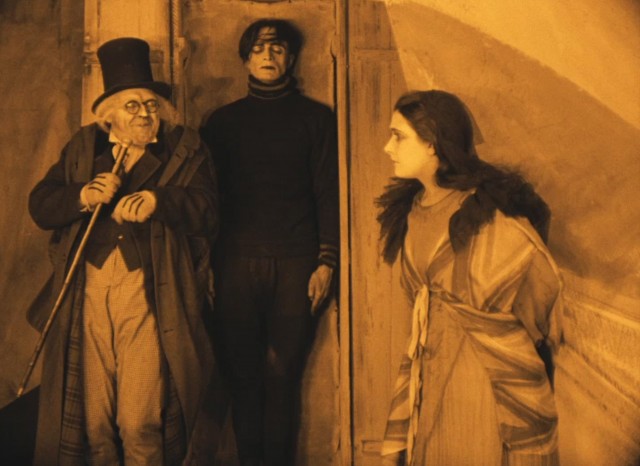
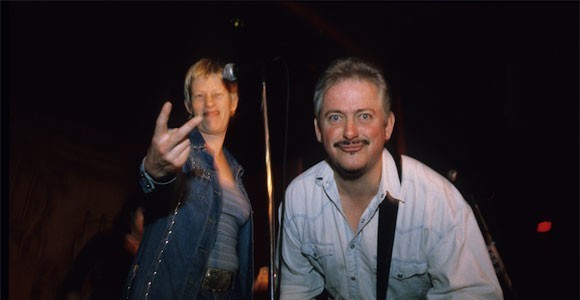
 Called “the most revolutionary group in the history of rock ‘n’ roll” by Lester Bangs,
Called “the most revolutionary group in the history of rock ‘n’ roll” by Lester Bangs, 